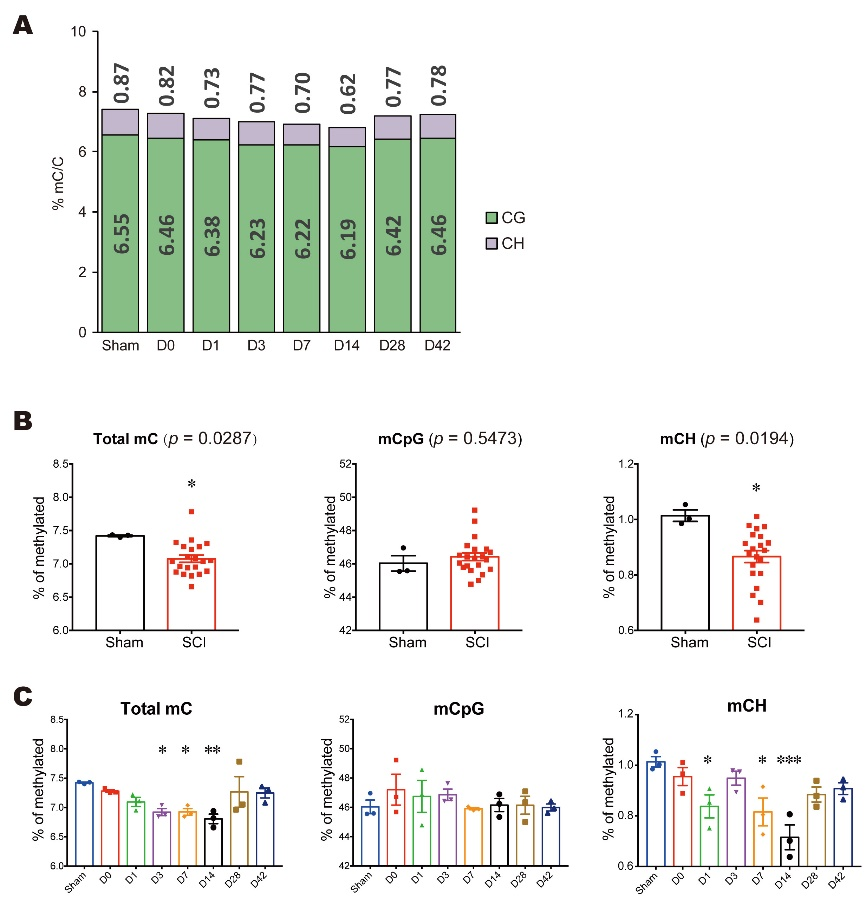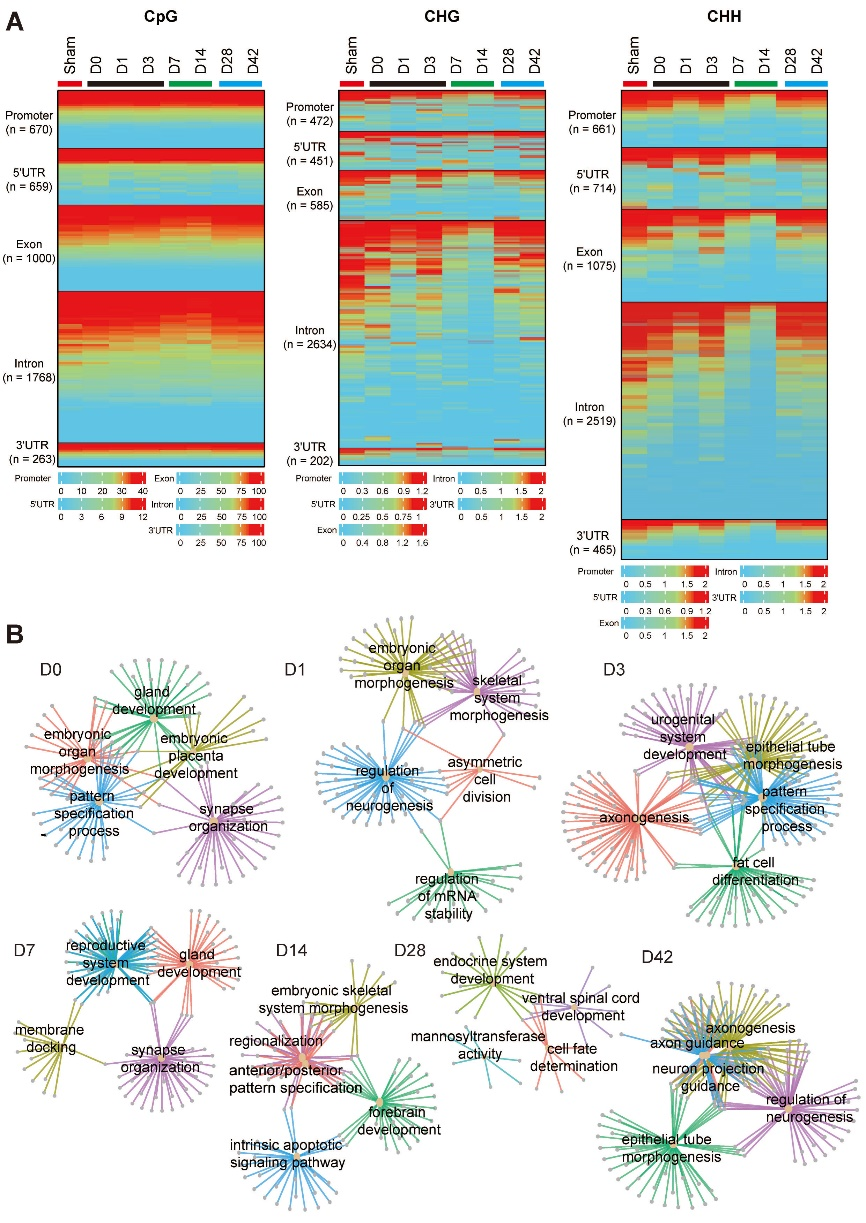NRR:同济大学附属同济医院程黎明团队发现非CPG甲基化降低是脊髓损伤后重要的表观遗传靶点
撰文:吴周睿,李琛,祝然,程黎明
脊髓损伤是一种椎管内神经组织的急性创伤性损伤,可产生多种神经问题,如感觉和运动反应功能障碍。然而,脊髓损伤后原发性和继发性损伤的主要分子功能过程仍不清楚。既往对脊髓损伤的转录组研究结果表明,基因表达模式随着时间的推移而变化[1]。除转录分析外,表观遗传分析,如微小RNA高通量测序也逐渐引起重视[2]。然而,只有少数研究探索了脊髓损伤后DNA甲基化状态的变化[3-5]。近年来,对脑发育过程中DNA甲基化模式的深入研究表明,DNA甲基化存在于特定的基因组区域,尤其是与染色质开放获取相关的区域,因此对转录启动至关重要,可导致发育过程中转录组的改变。DNA甲基化调控已被证明与多种脊髓损伤相关的功能反应密切相关。如DNA甲基化与神经元死亡有关[6],并能调控神经元轴突再生和生长锥发育[7],还可参与神经胶质细胞分化和命运的决定[8],以及促进炎症反应和激活[9]和血管生成[10]。因此,脊髓损伤后DNA甲基化状态的改变必须被认为是一个重要的调控因素。此外,解析脊髓损伤后功能反应的时序性也需要深入了解DNA甲基化改变的时间规律。
最近,中国同济大学附属同济医院程黎明团队在《中国神经再生研究(英文版)》(Neural Regeneration Research)上发表了题为“Reduced non-CpG methylation is a potential epigenetic target after spinal cord injury”的研究,发现脊髓损伤后DNA甲基化的整体降低,尤其是非CpG类。此外,DNA甲基化鉴定的脊髓损伤后功能时间窗结果与既往RNA测序的结果一致,强调了其在脊髓损伤中的重要作用。DNA甲基化与多梳家族(Polycomb group,PcG)共同参与转录调控,并主要靶向与再生相关的过程,如轴突发生和组织发育与再生。这一研究揭示,非CPG甲基化降低是小鼠脊髓损伤后重要的表观遗传靶点,可通过调控脊髓损伤后再生事件发挥重要的转录调控作用。
程黎明等建立了小鼠T9脊髓损伤的简化基因组甲基化测序(RRBS)库,并得出重要的发现(图1)。首先,脊髓损伤后DNA甲基化水平降低,大部分下降在非CpG甲基化区域。然后,利用层次聚类和主成分分析,确定甲基化相关疾病的时间窗口,发现第0-3天代表早期,第7-14天代表中期,第28-42天代表晚期。此外,甲基化损失在中期最为显著,而早期和晚期的低甲基化水平相似。对不同基因组区域的分析表明,DNA甲基化主要集中在基因间区域。正如预期的那样,转录起始位点的CpG甲基化缺失。此外,内含子中CHG和CHH甲基化水平明显高于其他区域。脊髓损伤后基线CpG和CHH甲基化水平增加,而CHG甲基化水平没有模型变化。与假手术组相比,脊髓损伤组中多个基因区域中CpG甲基化水平几乎没有改变。相比之下,启动子区、5'非翻译区、外显子、内含子和3'非翻译区中的CHG和CHH甲基化水平均显著下降。

图1甲基化胞嘧啶在小鼠脊髓损伤后CG和非CG环境中是动态且丰富的(图源:Wu et al., Neural Regen Res, 2023)
另外,研究还关注于基因启动子区域中DNA甲基化的改变,鉴定出由于脊髓损伤而导致的高甲基化或低甲基化的基因,并对进行聚类和功能注释。DNA甲基化标记是中枢神经系统中的主要表观遗传调节因子,程黎明等揭示了脊髓损伤后每个阶段的特点(图2)。CpG甲基化显示出明确的阶段特异性聚类。基于CpG和非CpG甲基化之间的簇差异,使用分层聚类方法可将脊髓损伤分为3组。第1组包含第0,1和3天,第2组包括第7和14 天,第3组包括第28和42天,这3组分别代表了脊髓损伤的早中晚期。此外,每个组之间的距离显示了明确的时间特性。接下来根据3个损伤阶段重新评估DNA甲基化水平,发现非CpG甲基化是甲基化下降的主力。

图2 CpG甲基化模式决定了脊髓损伤后的功能分期(图源:Wu et al., Neural Regen Res, 2023)
紧接着,研究使用SeqMonk及其注释数据库来研究差异甲基化区在不同基因组元件中的行为,以全面了解其的变化(图3)。结果发现,非CpG,而不是CpG的差异甲基化区发生了显著的改变,与既往研究一致,非CpG区的绝对甲基化水平远低于CpG区。CpG和非CpG的差异甲基化区在脊髓损伤后早期和中期呈现出低甲基化状态。第14天后,甲基化水平逐渐恢复,但与假手术组仍有相当程度差距。为阐明每个时间点DNA甲基化的功能过程,对不同时间点对启动子差异甲基化区簇进行了基因本体(GO)分析,结果发现CpG甲基化主要参与早期和晚期的神经发生相关调节机制。

图3脊髓损伤后不同时间时CpG、CHG和CHH背景下差异甲基化区的变化(图源:Wu et al., Neural Regen Res, 2023)
既往研究认为,基因DNA甲基化对哺乳动物中枢神经系统的发育、成熟和疾病发病具有深远影响,其与转录直接相关[11]。为更好地了解脊髓损伤后DNA甲基化和基因表达调控的机制,程黎明等对损伤后脊髓环境和区域的DNA甲基化和基因表达水平进行了Pearson相关分析(图4)(使用的基因表达数据是从既往研究中收集的[1])。关于CpG甲基化,启动子和内含子甲基化水平与基因表达水平呈负相关,但外显子CpG甲基化水平与基因转录水平无关。而CHG和CHH甲基化水平与启动子、外显子和内含子中的基因转录水平均呈负相关。此外,启动子中DNA甲基化与不同时间间隔的基因转录之间存在负相关。CpG和CH簇1和2以中等水平表达,其甲基化水平大于其他簇。簇5和6表现出相反的模式,具有更高的基因表达水平,但较低的DNA甲基化水平。尽管脊髓损伤后15 min内(第0天)基因转录的累积改变不明显,但与假手术组相比,DNA甲基化,特别是CHG和CHH甲基化均发生了显著的变化。检查脊髓损伤的早期和中期阶段,可发现转录上调基因中的DNA甲基化水平均出现下降。

图4 脊髓损伤中DNA甲基化与基因转录的相关性(图源:Wu et al., Neural Regen Res, 2023)
综上,从脊髓损伤的早期到晚期,DNA甲基化与神经元/轴突再生、突触形成、离子通道、囊泡转运、微管形成和神经回路投射构建有关。多个神经发育信号通路,包括WNT、转化生长因子和胰岛素样生长因子通路,都依赖于DNA甲基化。DNA甲基化对于通过蛋白质修饰系统介导的下游过程也至关重要,如磷酸化、泛素化、糖基化和其他修饰,以及Ras、MAPK、PI3K-AKT和Hippo通路,表明其在蛋白质成熟、激活、失活和降解中均起着至关重要的作用。DNA甲基化标记可与其他表观遗传改变标记相互作用,主要是组蛋白修饰标记,表明脊髓损伤后DNA甲基化对基因转录的控制涉及与其他表观遗传过程的协同作用。DNA甲基化参与调控转录复合物相关过程,特别是那些涉及PcG家族转录因子的过程,对基因转录至关重要。因此这一研究详细描述了DNA甲基化所起的作用以及脊髓损伤过程中这种修饰的动态特征。
然而,仍存在一些问题无法通过RRBS技术来回答,RRBS是基于甲基化敏感的限制性内切酶(Msp1),其富集了基因组周围CCGG含量的胞嘧啶甲基化,但含有CpG识别位点的数量太少,基因组覆盖率低。另外其不能用于区分由TET蛋白家族成员介导的甲基化胞嘧啶(5mC)和羟甲基化胞嘧啶(5hmC)。全基因组甲基化测序(WGBS)为研究CpG岛以外的感兴趣区域提供了思路,氧化亚硫酸氢盐测序(oxBS-Seq)揭示5hmC修饰模式也将是个有趣的研究方向。此外,单细胞RRBS或带流式细胞术的RRBS可进一步研究DNA甲基化如何调节不同细胞类型中的基因转录的详细信息。
原文链接:https://doi.org/10.4103/1673-5374.371399
参考文献
[1] Li C, Wu Z, Zhou L, et al. Temporal and spatial cellular and molecular pathological alterations with single-cell resolution in the adult spinal cord after injury. Signal Transduct Target Ther. 2022;7(1):65.
[2] Liu NK, Wang XF, Lu QB, et al. Altered microRNA expression following traumatic spinal cord injury. Exp Neurol. 2009;219(2):424-429.
[3] Shi GD, Zhang XL, Cheng X, et al. Abnormal DNA methylation in thoracic spinal cord tissue following transection injury. Med Sci Monit. 2018;24:8878-8890.
[4] Boni JL, Kahanovitch U, Nwaobi SE, et al. DNA methylation: a mechanism for sustained alteration of KIR4.1 expression following central nervous system insult. Glia. 2020;68(7):1495-1512.
[5] Davaa G, Hong JY, Kim TU, et al. Exercise ameliorates spinal cord injury by changing DNA methylation. Cells. 2021;10(1):143.
[6] Chestnut BA, Chang Q, Price A, et al. Epigenetic regulation of motor neuron cell death through DNA methylation. J Neurosci. 2011;31(46):16619-16636.
[7] Mahar M, Cavalli V. Intrinsic mechanisms of neuronal axon regeneration. Nat Rev Neurosci. 2018;19(6):323-337.
[8] Wu Z, Huang K, Yu J, et al. Dnmt3a regulates both proliferation and differentiation of mouse neural stem cells. J Neurosci Res. 2012;90(10):1883-1891.
[9] Celarain N, Tomas-Roig J. Aberrant DNA methylation profile exacerbates inflammation and neurodegeneration in multiple sclerosis patients. J Neuroinflammation. 2020;17(1):21.
[10] Sabbagh MF, Heng JS, Luo C, et al. Transcriptional and epigenomic landscapes of CNS and non-CNS vascular endothelial cells. Elife. 2018;7:e36187.
[11] Moore LD, Le T, Fan G. DNA methylation and its basic function. Neuropsychopharmacology. 2013;38(1):23-38.
 #br#
#br#
通讯作者:程黎明,主任医师,教授,博士生导师。同济大学附属同济医院骨科学科带头人,脊柱脊髓损伤再生修复教育部重点实验室主任、上海市重中之重重点学科骨外科带头人、上海市重点专科脊柱外科带头人、国家万人计划科技创新领军人才、国家重点研发计划首席科学家、国家百千万人才工程人选、国家有突出贡献中青年专家、国家特殊津贴获得者、上海领军人才、上海市科技精英、上海医学发展杰出贡献奖获得者、上海市先进工作者。同时担任世界神经修复学会(IANR)理事、中国研究型医院神经转化研究专委会副主任委员、上海市医师协会骨科医师分会副会长等。
程黎明教授临床主攻脊柱脊髓损伤的再生修复、脊柱退变性疾病的微创化治疗以及脊柱外科疑难杂症的诊治与康复,并率先提出了“早期损伤控制、全过程康复”的脊髓损伤救治策略,组建了“外科-康复-生物一体化”团队,主持国家重点研发计划、国家自然科学基金重点项目等20余项。发表论文百余篇,其中Cell、Nature Medicine、Advanced Materials等SCI、EI收录论文60余篇;中华核心期刊30余篇。主编著作3部;获批专利17项,其中发明专利11项;获中国康复医学会科学技术奖一等奖、上海市康复医学会科学技术奖一等奖、华夏医学科技奖一等奖、上海市科技进步奖一等奖、上海市科技进步奖推广奖等省部级奖励10余项。




 #br#
#br#